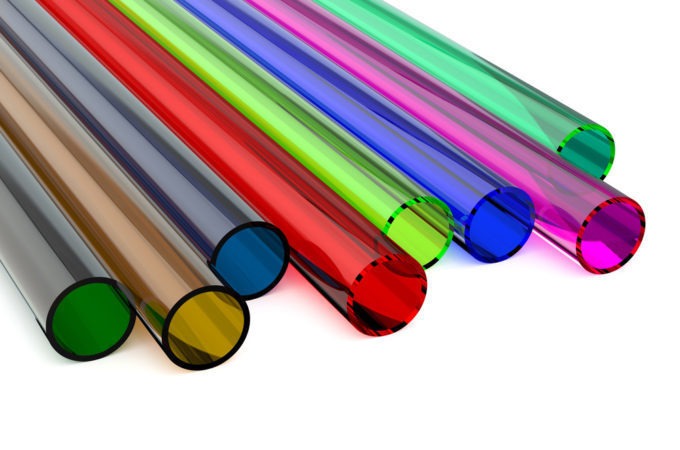As with many cases in manufacturing, you have options when it comes to injection molding. While there are a host of plastic materials that lend themselves to the process, they all generally fall into two broad categories: thermoplastic and thermoset materials. Each type of material offers different properties, benefits and strengths; and today, we’re going to focus on the importance of thermoplastic materials.
 Starting out, thermoset and thermoplastic materials have very similar properties: They both liquefy upon heating — and become more fluid with further heat (meaning that they can be more or less viscous depending on temperature). They also both resolidify upon cooling. Here, though, is where the major difference between the two lies. Once a thermoset cools and hardens (or “cures”), it truly is set — it won’t reliquefy or melt if subjected to reheating. Thermoplastic polymers, on the other hand, will reliquefy with enough heat applied. The implications and importance of this key quality, and of using thermoplastics in general, are as follows:
Starting out, thermoset and thermoplastic materials have very similar properties: They both liquefy upon heating — and become more fluid with further heat (meaning that they can be more or less viscous depending on temperature). They also both resolidify upon cooling. Here, though, is where the major difference between the two lies. Once a thermoset cools and hardens (or “cures”), it truly is set — it won’t reliquefy or melt if subjected to reheating. Thermoplastic polymers, on the other hand, will reliquefy with enough heat applied. The implications and importance of this key quality, and of using thermoplastics in general, are as follows:
Thermoplastic waste can often be re-used. Material waste occurs at many touchpoints in the injection molding process: Material can cool and harden in runners and sprues before reaching the mold cavity. Flash can occur, creating the need for trimming. Plus, sometimes parts can fail and be rejected. With thermoplastics, rather than being discarded (creating a total loss on that material investment, which adds up, even on those small portions from runners or flash trimmings), that material can be recovered and remelted for use in future molding cycles.
The properties of thermoplastics make them a higher-yield material choice. Because thermoplastic can be recovered and reincorporated into the raw material supply, you will almost always see a higher piece yield overall from your material stock than if a thermoset was chosen. Although thermoplastics typically run higher in cost than thermoset materials, this potential for higher yield can more than make up the difference. Be sure to take that factor into account when researching and sourcing materials for your product.

Thermoplastics are much more conducive to recycling. Thermoset materials, since they do not melt or break down after curing, are essentially impossible to recycle. Thermoplastic materials, in contrast, lend themselves especially well to recycling, since they can easily be melted. In many states, there are legal thresholds and regulations in place for using recyclables in manufacturing — meaning that thermoplastic use is required in those cases.
Thermoplastics can be a great choice for prototyping. Since prototypes are only used to test the appearance and function of products, a re-usable material makes an ideal solution. Once a prototype has been created, examined, tested and so on, it can simply be melted and used again — either for prototyping or production. Do keep in mind that injection molding for prototypes can be cost prohibitive, even when taking the efficiency benefits of thermoplastics into account. If, however, a highly functional, true-to-life prototype is required via injection molding, be sure to strongly consider a thermoplastic.

Thermoplastics are ideal for high-impact applications. The molecular qualities of thermoplastics make them extremely suitable for applications where high strength and stress resistance is required. While thermosets are useful in situations where rigidity and structural integrity are important, the strength and flexibility of thermoplastics make them more versatile across a broad range of use cases.
Thermoplastics lend themselves to thin-wall uses. The strong yet flexible nature of thermoplastics means that they are a top choice for applications where both high-tensile strength and extremely thin gauge (or wall thickness) are necessities. Think of uses like packaging film or plastic bags — with a small amount of force, they can be easily broken (often as intended), but they hold up to normal use and impact.
Thermoplastics are receptive to surface finishing. With thermoset materials, although they typically yield a pleasing final appearance, they are more difficult to apply custom finishes to, for instance ink or paint. Thus, for products or pieces where logos or decorations must be applied, thermoplastics are the better choice. They lend themselves to a broad range of surface-finishing methods and materials, making them an extremely versatile choice for consumer products and the like.
The above points represent some true benefits of thermoplastics. There are some other material properties of thermoplastics to know as well, in order to make a well-informed decision about which type of material to choose.
Thermoplastics are not the best choice for high-temperature applications. As we’ve learned, when subjected to enough heat, thermoplastic materials will reliquefy. This, naturally, makes them a poor choice for applications where they may be subjected to sustained high heat, for instance, outdoor uses or situations where they may be located near combustion or other heat sources. If choosing a thermoset material for such an application, however, be aware that while it will not melt, it will burn if subjected to a high enough temperature.
Both thermoplastics and thermosets are chemical-resistant. Depending on the material you choose, thermoplastic and thermoset polymers both offer exceptional levels of chemical resistance. This makes them good choices for medical devices and materials, as well as other scenarios where exposure to chemicals may occur, and resistance or protection is required.
What are some types of thermoset and thermoplastic materials? Thermosets are usually hard, rigid materials known as “resins.” They are typically found in insulation and sealing applications, thanks to their high degree of structural integrity. Thermoplastics cover a broad range of well-known plastic materials, including nylon (also highly suitable for 3D printing), acrylic, HDPE and LDPE (high- and low-density polyethylene), polystyrene and polypropylene. These are the materials you see in any number of recyclable consumer products, as well as many industrial, medical and other uses.
Although we’ve presented many benefits of thermoplastics here, it’s important to know that one type of material is not inherently superior to the other. The key is knowing which type of material is best for your product, its needs and requirements, your budget, your supply chain and more. With these points in hand, you can look at the qualities of each material type, and make the decision that works for you.


